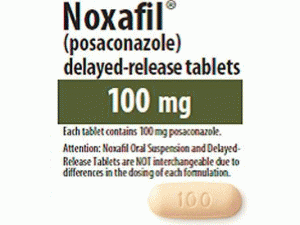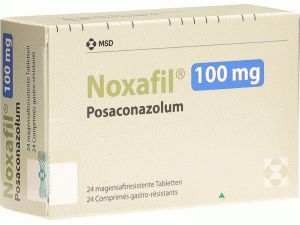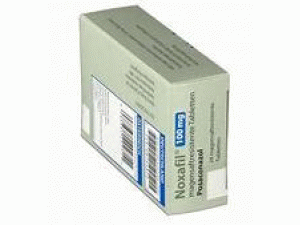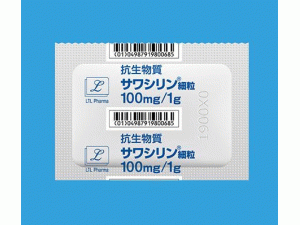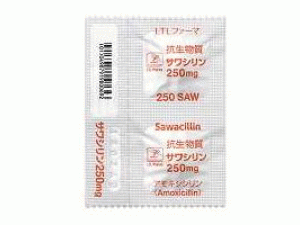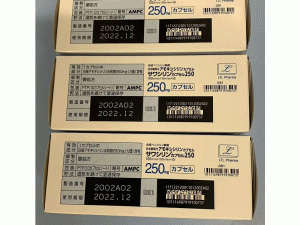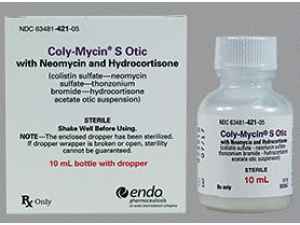注射用硫酸多粘菌素B(polymyxin B for injection USP)
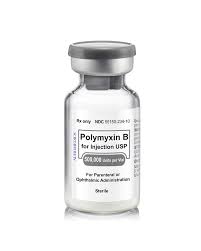 产地国家:美国
处 方 药:是
所属类别:50万单位/支 10支注射液/盒
包装规格:50万单位/支 10支注射液/盒
计价单位:盒
生产厂家中文参考译名:Xgen
生产厂家英文名:Xgen
原产地英文商品名:POLYMYXIN B SULFATE 500000 UNITS/VIAL 10VIALS/BOX
原产地英文药品名:POLYMYXIN B SULFATE
中文参考商品译名:POLYMYXIN注射液 B-50万单位/支 10支/盒
中文参考药品译名:多粘菌素 B
产地国家:美国
处 方 药:是
所属类别:50万单位/支 10支注射液/盒
包装规格:50万单位/支 10支注射液/盒
计价单位:盒
生产厂家中文参考译名:Xgen
生产厂家英文名:Xgen
原产地英文商品名:POLYMYXIN B SULFATE 500000 UNITS/VIAL 10VIALS/BOX
原产地英文药品名:POLYMYXIN B SULFATE
中文参考商品译名:POLYMYXIN注射液 B-50万单位/支 10支/盒
中文参考药品译名:多粘菌素 B
简介
部分中文多粘菌素B处方资料(仅供参考) 通用名:注射用硫酸多粘菌素B 英文名:Polymyxini B Sulphas for Injection 汉语拼音:Zhusheyong Liusuan DuonianjunsuB 剂型:注射剂(冻干粉) 注射用硫酸多粘菌素B 英文名称:Polymyxin B Sulfate(Aerosporin) 性状 包括本品在内的多粘菌素类抗生素,在生理Ph时为阳离子表面活性化合物,作用于敏感菌质膜中磷脂组分,破坏细胞膜的渗透完整性而产生抗菌作用,但确切机制仍未尽悉。多粘菌素均系杀菌剂。 本品对很多革兰阴性需氧菌都有效,尤对绿脓杆菌。对大肠杆菌、肺炎杆菌、肠杆菌、沙门菌、志贺菌、嗜血杆菌、博德特菌、巴斯德菌和弧菌有效。但变形菌、天命菌及粘质沙雷菌则常耐药。本品对奈瑟菌、革兰阳性菌、多数厌氧菌及真菌无效。 本品与多粘菌素E有叉耐药性,但与其他抗生素无交叉耐药性。细菌对本品的获得性耐药发生缓慢。 作用与作用机制 本品口服不吸收。肌注约2h达血药峰浓度,血药峰浓度个体间差异较大。本品可分布至肝、肾、脑、心、肌肉和肺等组织中,但不能进入脑脊液。主要经肾脏排泄,半衰期约6-7h,肾功能障碍时延长。血液透析难以清除。 药动学: 1、药品具有肾毒性,与剂量相关,常见且严重,表现为血脲氮(BUN)和血清肌酐增高,轻微者停药可恢复,偶有肾衰竭和急性肾小管坏死者。剂量过大或用药时间长者更易发生。 2、神经毒性亦是本品常见不良反应,表现为暂时性神经系统改变,如眩晕、共济失调、口齿迟钝、视物模糊、嗜睡、精神错乱、肢体麻木、口感异常等。多与剂量有关。停药可消失。较大剂量可致神经肌肉阻滞,造成呼吸停顿。 3、本品亦可发生过敏反应,出现瘙痒、皮疹、药物热等症。严重者出现休克。 4、本品肌注疼痛明显。偶可引起白细胞减少? 注意事项 1、本品应避免与肾毒性药物(如氨基糖苷类抗生素等)合用,以免毒性增加。 2、本品可引起神经肌肉阻滞,故不应与骨骼肌松弛剂、氨基糖苷类抗生素、肌肉松弛作用明显的麻醉药(如恩氟烷)等合用。亦不可同时静脉应用奎宁、镁剂等。日剂量中至少有一半需静脉滴注,不可一次迅速推注,以免发生广泛性神经肌肉阻滞。 3、本品与磺胺类药物、利福平、半合成青霉素等合用,用于治疗严重耐药革兰阴性菌感染,效果优于单独应用。 临床应用 静脉注射或滴注:成人和儿童,每日每千克体重1.5-2.5mg,分2-3次给予。 用法计量 粉针剂:50mg(50万U)。 Polymyxin B 注射用硫酸多粘菌素B英文版说明书
POLYMYXIN B (polymyxin b sulfate) injection, powder, lyophilized, for solution [APP Pharmaceuticals, LLC] WARNING CAUTION: WHEN THIS DRUG IS GIVEN INTRAMUSCULARLY AND/OR INTRATHECALLY, IT SHOULD BE GIVEN ONLY TO HOSPITALIZED PATIENTS, SO AS TO PROVIDE CONSTANT SUPERVISION BY A PHYSICIAN. RENAL FUNCTION SHOULD BE CAREFULLY DETERMINED AND PATIENTS WITH RENAL DAMAGE AND NITROGEN RETENTION SHOULD HAVE REDUCED DOSAGE. PATIENTS WITH NEPHROTOXICITY DUE TO POLYMYXIN B SULFATE USUALLY SHOW ALBUMINURIA, CELLULAR CASTS, AND AZOTEMIA. DIMINISHING URINE OUTPUT AND A RISING BUN ARE INDICATIONS FOR DISCONTINUING THERAPY WITH THIS DRUG. NEUROTOXIC REACTIONS MAY BE MANIFESTED BY IRRITABILITY, WEAKNESS, DROWSINESS, ATAXIA, PERIORAL PARESTHESIA, NUMBNESS OF THE EXTREMITIES, AND BLURRING OF VISION. THESE ARE USUALLY ASSOCIATED WITH HIGH SERUM LEVELS FOUND IN PATIENTS WITH IMPAIRED RENAL FUNCTION AND/OR NEPHROTOXICITY. THE CONCURRENT OR SEQUENTIAL USE OF OTHER NEUROTOXIC AND/OR NEPHROTOXIC DRUGS WITH POLYMYXIN B SULFATE, PARTICULARLY BACITRACIN, STREPTOMYCIN, NEOMYCIN, KANAMYCIN, GENTAMICIN, TOBRAMYCIN, AMIKACIN, CEPHALORIDINE, PAROMOMYCIN, VIOMYCIN, AND COLISTIN SHOULD BE AVOIDED. THE NEUROTOXICITY OF POLYMYXIN B SULFATE CAN RESULT IN RESPIRATORY PARALYSIS FROM NEUROMUSCULAR BLOCKADE, ESPECIALLY WHEN THE DRUG IS GIVEN SOON AFTER ANESTHESIA AND/OR MUSCLE RELAXANTS. USAGE IN PREGNANCY: THE SAFETY OF THIS DRUG IN HUMAN PREGNANCY HAS NOT BEEN ESTABLISHED. DESCRIPTION Polymyxin B for Injection, USP is one of a group of basic polypeptide antibiotics derived from B polymyxa (B aerosporous). Polymyxin B sulfate is the sulfate salt of Polymyxins B1 and B2, which are produced by the growth of Bacillus polymyxa (Prazmowski) Migula (Fam. Bacillacea). It has a potency of not less than 6000 polymyxin B units per mg, calculated on the anhydrous basis. The structural formulae are: Each vial contains 500,000 polymyxin B units for parenteral or ophthalmic administration. Polymyxin B for Injection is in powder form suitable for preparation of sterile solutions for intramuscular, intravenous drip, intrathecal, or ophthalmic use. In the medical literature, dosages have frequently been given in terms of equivalent weights of pure polymyxin B base. Each milligram of pure polymyxin B base is equivalent to 10,000 units of polymyxin B and each microgram of pure polymyxin B base is equivalent to 10 units of polymyxin B. Aqueous solutions of polymyxin B sulfate may be stored up to 12 months without significant loss of potency if kept under refrigeration. In the interest of safety, solutions for parenteral use should be stored under refrigeration and any unused portion should be discarded after 72 hours. Polymyxin B sulfate should not be stored in alkaline solutions since they are less stable. CLINICAL PHARMACOLOGY Polymyxin B sulfate has a bactericidal action against almost all gram-negative bacilli except the Proteus group. Polymyxins increase the permeability of bacterial cell wall membranes. All gram-positive bacteria, fungi, and the gram-negative cocci, N gonorrhoeae and N meningitidis, are resistant. Susceptibility plate testing: If the Kirby-Bauer method of disc susceptibility testing is used, a 300-unit polymyxin B disc should give a zone of over 11 mm when tested against a polymyxin B susceptible bacterial strain. Polymyxin B sulfate is not absorbed from the normal alimentary tract. Since the drug loses 50 percent of its activity in the presence of serum, active blood levels are low. Repeated injections may give a cumulative effect. Levels tend to be higher in infants and children. The drug is excreted slowly by the kidneys. Tissue diffusion is poor and the drug does not pass the blood brain barrier into the cerebrospinal fluid. In therapeutic dosage, polymyxin B sulfate causes some nephrotoxicity with tubule damage to a slight degree. INDICATIONS AND USAGE To reduce the development of drug-resistant bacteria and maintain the effectiveness of polymyxin B and other antibacterial drugs, polymyxin B should be used only to treat or prevent infections that are proven or strongly suspected to be caused by bacteria. When culture and susceptibility information are available, they should be considered in selecting or modifying antibacterial therapy. In the absence of such data, local epidemiology and susceptibility patterns may contribute to the empiric selection of therapy. Acute Infections Caused by Susceptible Strains of Pseudomonas aeruginosa Polymyxin B sulfate is a drug of choice in the treatment of infections of the urinary tract, meninges, and bloodstream caused by susceptible strains of P aeruginosa. It may also be used topically and subconjunctivally in the treatment of infections of the eye caused by susceptible strains of P aeruginosa. It may be indicated in serious infections caused by susceptible strains of the following organisms, when less potentially toxic drugs are ineffective or contraindicated: H influenzae, specifically meningeal infections. Escherichia coli, specifically urinary tract infections. Aerobacter aerogenes, specifically bacteremia. Klebsiella pneumoniae, specifically bacteremia. NOTE: IN MENINGEAL INFECTIONS, POLYMYXIN B SULFATE SHOULD BE ADMINISTERED ONLY BY THE INTRATHECAL ROUTE. CONTRAINDICATIONS This drug is contraindicated in persons with a prior history of hypersensitivity reactions to polymyxins. PRECAUTIONS See “WARNING” box. General Prescribing polymyxin B in the absence of a proven or strongly suspected bacterial infection or a prophylactic indication is unlikely to provide benefit to the patient and increases the risk of the development of drug resistant bacteria. Baseline renal function should be done prior to therapy, with frequent monitoring of renal function and blood levels of the drug during parenteral therapy. Avoid concurrent use of a curariform muscle relaxant and other neurotoxic drugs (ether, tubocurarine, succinylcholine, gallamine, decamethonium and sodium citrate) which may precipitate respiratory depression. If signs of respiratory paralysis appear, respiration should be assisted as required, and the drug discontinued. As with other antibiotics, use of this drug may result in overgrowth of nonsusceptible organisms, including fungi. If superinfection occurs, appropriate therapy should be instituted. Information for Patients Patients should be counseled that antibacterial drugs including polymyxin B should only be used to treat bacterial infections. They do not treat viral infections (e.g., the common cold). When polymyxin B is prescribed to treat a bacterial infection, patients should be told that although it is common to feel better early in the course of therapy, the medication should be taken exactly as directed. Skipping doses or not completing the full course of therapy may (1) decrease the effectiveness of the immediate treatment and (2) increase the likelihood that bacteria will develop resistance and will not be treatable by polymyxin B or other antibacterial drugs in the future. ADVERSE REACTIONS See “WARNING” box. Nephrotoxic reactions: Albuminuria, cylinduria, azotemia, and rising blood levels without any increase in dosage. Neurotoxic reactions: Facial flushing, dizziness progressing to ataxia, drowsiness, peripheral paresthesias (circumoral and stocking glove), apnea due to concurrent use of curariform muscle relaxants, other neurotoxic drugs or inadvertent overdosage, and signs of meningeal irritation with intrathecal administration, e.g., fever, headache, stiff neck and increased cell count and protein cerebrospinal fluid. Other reactions occasionally reported: Drug fever, urticarial rash, pain (severe) at intramuscular injection sites, and thrombophlebitis at intravenous injection sites. DOSAGE AND ADMINISTRATION Parenteral Intravenous Dissolve 500,000 polymyxin B units in 300 to 500 mL solutions for parenteral dextrose injection 5% for continuous drip. Adults and children: 15,000 to 25,000 units/kg body weight/day in individuals with normal kidney function. This amount should be reduced from 15,000 units/kg downward for individuals with kidney impairment. Infusions may be given every 12 hours; however, the total daily dose must not exceed 25,000 units/kg/day. Infants: Infants with normal kidney function may receive up to 40,000 units/kg/day without adverse effects. Intramuscular Not recommended routinely because of severe pain at injection sites, particularly in infants and children. Dissolve 500,000 polymyxin B units in 2 mL sterile water for injection or sodium chloride injection or procaine hydrochloride injection 1%. Adults and children: 25,000 to 30,000 units/kg/day. This should be reduced in the presence of renal impairment. The dosage may be divided and given at either 4 or 6 hour intervals. Infants: Infants with normal kidney function may receive up to 40,000 units/kg/day without adverse effects. Note: Doses as high as 45,000 units/kg/day have been used in limited clinical studies in treating prematures and newborn infants for sepsis caused by P aeruginosa. Intrathecal A treatment of choice for P aeruginosa meningitis. Dissolve 500,000 polymyxin B units in 10 mL sodium chloride injection USP for 50,000 units per mL dosage unit. Adults and children over 2 years of age: Dosage is 50,000 units once daily intrathecally for 3 to 4 days, then 50,000 units once every other day for at least 2 weeks after cultures of the cerebrospinal fluid are negative and sugar content has returned to normal. Children under 2 years of age: 20,000 units once daily, intrathecally for 3 to 4 days or 25,000 units once every other day. Continue with a dose of 25,000 units once every other day for at least 2 weeks after cultures of the cerebrospinal fluid are negative and sugar content has returned to normal. IN THE INTEREST OF SAFETY, SOLUTIONS OF PARENTERAL USE SHOULD BE STORED UNDER REFRIGERATION, AND ANY UNUSED PORTIONS SHOULD BE DISCARDED AFTER 72 HOURS. Topical Ophthalmic: Dissolve 500,000 polymyxin B units in 20 to 50 mL sterile water for injection or sodium chloride injection USP for a 10,000 to 25,000 units per mL concentration. For the treatment of P aeruginosa infections of the eye, a concentration of 0.1 percent to 0.25 percent (10,000 units to 25,000 units per mL) is administered 1 to 3 drops every hour, increasing the intervals as response indicates. Subconjunctival injection of up to 100,000 units/day may be used for the treatment of P aeruginosa infections of the cornea and conjunctiva. Note: Avoid total systemic and ophthalmic instillation over 25,000 units/kg/day. HOW SUPPLIED Polymyxin B for Injection, USP, 500,000 polymyxin B units per vial is supplied as follows. Product No. NDC No. Strength Vial size 320110 63323-321-10 500,000 U/Vial Vial packaged in tens. Storage Recommendations Before reconstitution: Store at 20° to 25°C (68° to 77°F)[see USP Controlled Room Temperature]. Protect from light. Retain in carton until time of use. After reconstitution: Product must be stored under refrigeration, between 2° to 8°C (36° to 46°F) and any unused portion should be discarded after 72 hours. Vial stoppers do not contain natural rubber latex.用药温馨提示:当您服用此药物时,需定期接受医疗专业人士的检查,以便随时针对其药效、副作用等情况进行监测。本网站所包含的信息旨在为患者提供帮助,不能代替医学建议和治疗。
药品价格查询,专业药品查询网站,药品说明书查询,药品比价 » 注射用硫酸多粘菌素B(polymyxin B for injection USP)
药品价格查询,专业药品查询网站,药品说明书查询,药品比价 » 注射用硫酸多粘菌素B(polymyxin B for injection USP)

